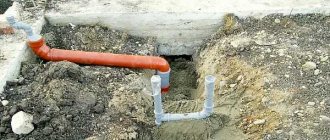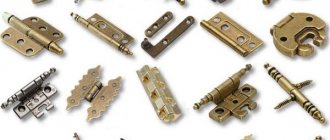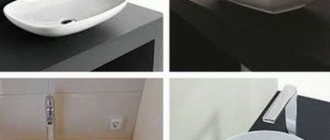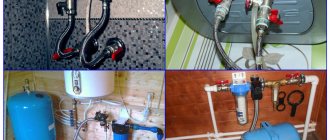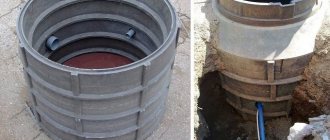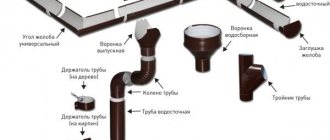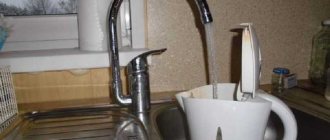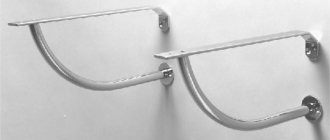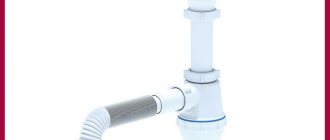Bracket installation technology
- Determine the density of the load-bearing wall using a small-diameter drill. If the wall is not dense, then powerful and long dowels will be needed for fastening.
- Drill through the plaster to the base (brick, concrete, other material), going 3-4 cm deep into it.
- Choose special anchors with a length of 8 to 12 cm.
- Be sure to insert a plastic or nylon dowel.
- Secure the bracket.
- Check the installed (attached) bracket for reliability: pull it with your hand - it should not move.
- Proceed to install the bowl onto the attached brackets.
Attaching the sink will not be a big problem if you do not disturb the order of work
It is important to choose high-quality brackets that match the type of bowl
Now you know how to secure a sink. Mounting on brackets is the most difficult installation option. They need to be matched to the interior of the bathroom and securely fixed, because there will be no other support for the sink.
Installing a bathroom sink on a pedestal
Otherwise, a washbasin on a pedestal is called a “tulip”, due to its similarity when fully assembled to a real flower. This mounting option fits any bathroom design. In this case, the quality of the walls and the type of covering do not matter at all, since the sink will not need to be hung. Her leg will act as a support. You can choose any location for the pedestal, hide pipes, communications, and wall defects behind it. This installation option will make the bathroom cozy and neat.
The design options for supports can be very different - square, round, polygonal. Any of the pedestals securely holds the sink and complies with all ergonomic rules, despite the inability to use the space under the bowl. Installing a tulip washbasin can be done alone.
If the washbasin being installed is a “tulip”, then there is no need to talk about adjusting it in height, because these products come in standard parameters and sizes.
Installation of a sink without brackets
A mounting kit must be included with the sink upon purchase; if for some reason it is not available or the quality leaves much to be desired, purchase such a kit separately. Focus on products from well-known brands so as not to worry about the quality of installation later.
Decide on the location where the sink will be installed and take measurements. It is usually recommended to install the bowl at a height of 70 - 85 cm from the floor.
At the selected height according to the building level, draw a horizontal line. Now we place the upper edge of the bowl to the set aside line and mark the attachment points. We drill holes according to the marks and insert dowels. We screw the pins into the dowels. The screwed-in pin should be 2 cm longer than the width of the washbasin. After final installation, tighten the nuts until they stop.
Installation of a mortise model
Installation of mortise washbasins in a bathroom using the overhead method begins with screwing taps for supplying hot and cold water onto the supply pipes coming out of the wall. If problems arise with the mixer and/or flexible supply hoses, it is enough to turn off the tap and eliminate the defect.
- We lower the sink to a permanent location: into the hole in the countertop or cabinet. We trace the outline with chalk or pencil.
- We take out the bowl and turn it upside down to connect the mixer.
- We screw flexible hoses for supplying hot and cold water to the mixer.
- To prevent water from leaking under the sink, we put on an o-ring. We pass the hoses through the hole in the bowl. We put on a rubber washer on the reverse side and screw the pin into the base of the tap. Screw and tighten the nut on top.
- Apply a silicone layer along the edge of the opening (top and side) in the tabletop. The thickness of the layer should be sufficient for a tight fit of the surfaces.
- We put the sink in place strictly along the outlined line. Remove excess silicone.
- Cover the space adjacent to the bowl and the edge of the bowl with masking tape. We cover the seam between the sink and the countertop with white silicone. Remove excess with a damp sponge. After 30 minutes, remove the tape. Use a rubber round spatula to straighten the seam.
It is necessary to check in advance the length of the hoses in the purchased kit and the presence of fasteners.
What to do if the purchased cabinet or countertop does not have a recess for the sink. The problem can be solved simply. Using the applied template, a hole of the required diameter is cut out. The edges are cleaned with fine-grained sandpaper.
Installation of a wall-mounted sink with a cabinet
This option is good because you can hide all the plumbing connections in the cabinet.
At the required height, draw a horizontal line along the level. We try on the cabinet, see how it will fit with the siphon and mixer. If necessary, immediately measure and drill additional holes for plumbing in the back wall. Now we install the brackets and the cabinet on them. We described above how the brackets are attached.
We install a washbasin on top, connect a siphon and sewerage to it. If the bowl model provides for additional fastening to the wall, then drill holes in the right places and tighten the anchor bolts. Or glue the sink to the wall with silicone for greater reliability.
Connection to utilities
Recommendations for connecting the mixer and drain fittings are common to all models of plumbing.
Screw the flexible hoses to the faucet. Insert the mixer into the corresponding hole in the shelf of the bowl. Connect the faucet hoses to the water taps.
Then install the drain neck. Unscrew the top plug. There is an overflow hole on the side of the neck. The sink also has an overflow hole. When the sink overflows, the water will drain out on its own through the overflow.
Insert the neck, aligning the overflow holes. We install one of the silicone gaskets on top of the neck. We put the second gasket on the bottom. Next, screw on and carefully tighten the nut. Replace the drain plug.
We screw the siphon from below. Using a corrugated pipe we connect it to the sewer. The sink is connected!
Secrets of the master
In order to efficiently install a sink on a wall, it is worth learning some of the nuances of this process, without which the installed structure will not be as reliable and stable. These are tips from the best installation specialists:
- The wall structure has a significant disadvantage - it is visually open pipelines and fittings. The excellent aesthetics of the bowl is achieved thanks to a cabinet that matches the design, which will cover all these connections and the siphon. An additional advantage of this installation is a good place to store various necessary accessories.
- In practice, the entire set of fastening equipment should be included with the product. Check this issue yourself, because often: either the manufacturer forgets to complete the sink with fasteners, or their quality itself is not particularly high.
- To avoid moisture vapors from entering the space between the bowl and the wall, it is necessary to use a high-quality sealant, for example, silicone.
Upon completion of installation work, check the system drainage for leaks by filling the siphon with water. If you find a leak, make a tighter twist and an additional sealing layer.
- Install the bowl only after completing all finishing work. Be very careful when installing fasteners.
- The surface of the wall on which you mount the bowl must be strong and stable, otherwise use a supporting frame.
- If after installation the sink does not “move”, this is a clear indicator that the bowl installation procedure was successful.
A well-executed installation procedure is synonymous with excellent functionality and durability of the product. In view of this, before installation work, seek the support of an experienced specialist.
Frame structure for installing a washbasin
If the walls in your bathroom are not strong enough to install a sink, and you really want just such a model, then you can solve this issue by installing a frame structure. It is attached to the floor and walls and consists of profiles. The height is adjustable with legs, so that the sink can be installed at the desired height from the floor. All communications are hidden inside the structure.
The procedure is as follows:
- the frame is leveled and secured to the floor and wall;
- At the required height, screws are screwed in to secure the sink;
- cover the frame with moisture-resistant plasterboard and line it with tiles or any other finishing material;
- between the wall and the sink, a rubber washer is placed on the stud to reduce noise during operation;
- attach the wall-mounted sink to studs on top of the cladding.
A properly assembled installation can withstand a load of up to 400 kg, and this is not only a sink, but also other plumbing fixtures. In addition, you can make a niche in the design and use it as a shelf.
Sink installation standards according to GOST and SNiP
During Soviet times, many state standards and building codes were created and established, which determine the rules for installing various plumbing fixtures. At the same time, the norms are still used today. Let's consider the main installation options according to existing approved documentation:
| Product type | Standard name | |||||
| Internal sanitary systems | Children's preschool institutions | Enameled steel sinks and sinks and steel brackets for sinks | Sanitary ceramic products | |||
| SNIP 3.05.01-85 clause 3.15 | SNiP II-64-80 clause 4.7 | GOST 24843-81 appendix 1.2 | GOST 30493-2017 clause 3.3.6 | |||
| Installation height from the finished floor level to the top of the side, mm | ||||||
| In residential, public, industrial buildings | In schools and children's hospitals | In nursery groups | In preschool groups | |||
| Washbasins | 800 | 700 | 400 | 500 | ||
| Sinks | 850 | 850 | 850 | |||
| Ceramic pedestal with washbasin | 800 | |||||
There are also other newer documents, for example SP 73.13330.2012 (updated edition of SNiP 3.05.01-85), where paragraph 6.3.4 indicates the same characteristics as in the original source.
The option of installing a sink on special cabinets also largely depends on the height and design of the cabinet itself and makes the sink less adjustable in height.
Specifics and models of wall-mounted sinks
The latest modern trend in sink installation is to mount the unit to the wall surface. This type of arrangement is one of the most familiar and favorite among Russians, since this type of installation has worthy and significant advantages. By installing the sink on the wall, you will save the desired meters of space, and the space under the sink is very convenient to use and keep clean.
Before you begin installation work, choose the model of wall-mounted sink that has the most ergonomic design. A separate model has specific design aspects, which, of course, affects the method of its installation. Therefore, it is so necessary to have at least some knowledge about the installation and specifics of connecting the device to the general water supply system.
An interesting solution is to install a sink above the washing machine; this saves precious space in the bathroom.
How to choose a hanging cabinet?
Basic Rules
- All cabinets will be divided according to the method of their installation. The most commonly used sink will be a pedestal sink called a "tulip". There are also overhead sinks that use a pipe. But there are also wall-mounted sinks, which we will now get acquainted with.
- Sinks can be in the form of a square, oval, rectangle, or triangle. Remember that any model will have rounded edges; this provides the necessary ergonomics during operation. Please note that a sink with rounded corners is much easier to clean than a model with sharp corners.
- Speaking about maximum popularity, it is necessary to mention the sink in the shape of an oval and a rectangle. There are also some advantages to such models. Firstly, they will take up a minimum amount of space, and secondly, absolutely all the capacity with which you work is easily accessible. The beauty is that when washing, water will not splash around.
- Many people say that sinks are installed most often in houses and apartments with VIP renovation. Naturally, the cost of implementing and creating such a model will not be small. It has certain dimensions, there are differences from the standard ones.
- Most often, the width of the sink will be determined not by the wishes of the family, but by the possibilities that exist in the bathroom. Naturally, you can use a fairly wide cabinet in the bathroom in combination with other elements, but this will make it lose its beauty and unusualness.
- There are sinks made of ceramics, glass, acrylic, granite, steel and cast iron. A popular option remains a bathroom made of earthenware. The durability of a faience sink is guaranteed by the fact that the surface of the material is coated with a special glaze.
Step-by-step installation instructions
https://youtube.com/watch?v=8d-LyqQfngQ
Mark the central horizontal line using a ruler, marker and spirit level. Installation will be carried out along its line
This will be, sort of, the upper limit of the bowl. It is important to consider the thickness of the side walls of the sink. They must be strong enough to withstand the pressure of the brackets
Measure the thickness and record the remaining parameters of the future installation on both sides of the bowl. Connect horizontally all the existing marks indicating the mounting height of the brackets. Finally, work begins on the sink itself. Turn the bowl over and fix the brackets on its outer walls.
- Move the sink closely to the horizontal and mark with a marker the places for mounting fasteners. This is done through recesses on the outside. Constantly check the alignment of all brackets and lines.
- Using a drill, make holes that are slightly smaller in diameter compared to the size of the fastening devices and dowel screws.
- Drive plugs or bushings made of durable plastic or nylon into the prepared drilled places, and screw the screws into them.
Support brackets are installed on this mount, on which the sink bowl is mounted. Mark the places where the device will be attached to the wall, drill and install the sink. Connect the outlet end of the siphon pipe into the socket of the sewerage system, install the mixer, and connect the water supply. Having made a light fastening “bait”, finish aligning the bowl horizontally. Then go through all the fasteners again and secure them.
Features of operation depending on the model
The types of fastening for a sink to the wall differ greatly depending on the modifications of the device:
For suspended installations, installation is carried out directly to the wall, so gravity is directed not only to the mount itself, but also to the wall
Therefore, it is very important that the base is strong and thick. Usually there are no problems with this if the installation is carried out in the place designated by the builders.
The “Tulip” model will look good in a spacious bathroom. When installing between the planes of the sink, floor and wall, polymer gaskets are installed, gluing them to silicone sealant
This technique prevents the appearance of squeaks and ringing of ceramics in the event of a careless impact. Another important point is that fastening and pulling the bowl to the wall should in no case cause it to be lifted on its “leg” in order to avoid splitting
Sanitary Plumbing Silicone | review
Excellent moisture resistant, an enemy of fungal mold, it is intended specifically for damp places and rooms. I will introduce you to one of the ones I have personally tested - Makroflex SH 101 . This is an acid type sealant. It has a strong vinegar smell as it thickens, but once it thickens, it dissipates.
It interacts well with materials such as steel, aluminum, pvc, ceramics, glass, enamel, etc. It is not afraid of sunlight and aging, it comes in white and transparent light. Sold in tubes and cartridges for special pistols. Sealant, as a material, is highly elastic and durable.
Its drying time takes, on average, one day or more, it all depends on the humidity and temperature in the room. After using it, try not to apply any mechanical or physical impact to the place where the sink is attached; you need to let it dry.
Before applying sanitary silicone sealant, the area where it is applied must be cleared of debris and dust and wiped with a dry cloth. It is advisable to degrease. It must be applied by evenly squeezing it onto the place where the object will be joined or the intermediate seam will be filled.
The result of our work using sanitary silicone is: a whole tile on your wall, simplicity, quality and the neighbors are not disturbed by the squeal of a hammer drill. When dismantling the washbasin, it will be enough to use a knife with a thin blade, just cut through our connection and that’s it.
The use of sanitary silicone has received positive feedback from users. He is praised by both specialist craftsmen and ordinary housewives. It is used to connect parts of home aquariums and many other connections, which you will learn about in the following notes.
When working with silicone, it is recommended to wear gloves. When it gets on clothes, it leaves a greasy stain that is difficult to remove later. Therefore, it is better not to use it in formal clothes. These are perhaps its most important disadvantages, and do not forget to check its expiration date before use.
There are many types of silicone. Everyone has their own purpose in different areas of activity. Remember! Your bathroom, like your kitchen, loves sanitary fixtures. If you don’t understand something, ask, ask questions, I will be happy to answer and add useful information to the note.
Types of sink brackets
The fasteners for mounting a washbasin on the wall must be able to withstand the weight of the plumbing fixtures with a margin. They are made from various metals.
special mounts designed for mounting a specific model. Often these are exclusive designer washbasins with an unusual shape. Brackets for such plumbing fixtures are included and can be made in the form of specially shaped pins, pipes that go around the sink, or unusual welded structures. Such fastenings are treated with special decorative compounds (ceramic or metal).
Brackets for standard wall-mounted sinks are made of cast iron or steel and coated with anti-corrosion paint. They are produced in the form of T-shaped or L-shaped racks, and can also be made in the form of frames with a sliding unit to adjust the size of the fastening. Brackets in the form of a metal frame into which the washbasin is placed are particularly reliable.
Tools and materials
For installation you will need: a sink, a set of auxiliary materials and various tools. Make sure everything is at hand. Tools you will need:
- Gas key.
- Electric drill + drill with pobedit tip.
- Screwdriver.
- Building level.
- Hammer.
- Marker.
- Special tape for threaded connections or tow.
The choice of fasteners is important if you have to deal with installing a sink in the bathroom for the first time. Most models are mounted on metal brackets, which come in different shapes (including openwork forged ones) and sizes. Installation is carried out using powerful bolts and studs. It is not always necessary to mount the sink to the wall. Depending on the model, it can only be placed on mounting brackets.
There are several types of shells:
Depending on the variety, the methods of attaching the bowl to the wall also differ. Most often, in about 50% of cases, conventional suspended structures are installed, this also includes “water lilies”. The installation of “tulip” type models is somewhat different: the bowl rests on the “leg”, and the sink needs to be attached to the wall only for additional fixation.
Siphon installation features
The siphon, like the mixer, can be attached before fixing the bowl or after. The ease of performing this operation determines the type of plumbing product. For example, a tulip sink, at the stage of screwing it to the wall, should already be equipped with a water seal, which will only need to be connected to the sewer. Otherwise, the decorative leg will create significant difficulties during the assembly of the drain fittings.
You can also use the option when only part of the drain (its upper part) is mounted on the washbasin, before it is secured. This is done if pipe or bottle type siphons are installed. If you have a corrugated water seal, then, in case of limited access under the washbasin, you will have to screw it in whole at once.
Preparatory work
The sink for the bathroom has been purchased, the necessary tools are ready, all that remains is to install the structure correctly. To do this, you need to prepare the wall on which the washbasin mounts will be mounted, and make markings so that the bowl is located at a height convenient for all household members.
The fastening for the sink to the wall must be installed after careful preparation of the surface. It is best if it has been finished (textured plaster, tiles or any other finishing material for the bathroom). If the wall is simply plastered, it must be treated with an antiseptic. There are many varieties of them in different price categories.
It is more convenient and easier to use liquid glass. It will perfectly protect the surface from exposure to water and at the same time destroy possible bacteria and fungi. After treatment, you need to wait a while until the surface is completely dry, then paint and begin installing the sink.
- Turn off cold and hot water.
- Stand at your full height in front of the installation site for the future sink.
- Select the upper limit for installing the bowl so that all household members can comfortably reach the sink.
- At the marked place, using a long ruler, pencil and level, draw a horizontal line along which the main work will be carried out.
- Check the dimensions of the sides of the bowl (measure it).
- Record the size with marks on both sides.
- Connect the marks with a horizontal line, thus obtaining the installation height of the sink brackets.
- Turn the bowl over and place it against the wall. Mark where the grooves for the brackets are.
How to remove an old sink?
We described the process of installing plumbing equipment in free space. If you are replacing an old sink with a new one, then problems arise with dismantling. When removing a sink, you need to follow several recommendations.
Use a measuring tape to measure the dimensions of the old sink. When installing a new sink, it is advisable to buy one that perfectly matches the size of the old one.
- Inspect the condition of the engineering systems, pay special attention to the condition of the threads. In old houses, the pipes were metal, and tow on oil paint was used as a seal. Such connections are very difficult to unscrew.
Use an adjustable wrench or wrench to loosen the bolts that secure the trap to the bottom of the sink. Turn the siphon towards the bucket, slowly detaching it from the sink. Prepare your tools. You will definitely need a gas wrench; all connecting couplings on water pipes cannot be unscrewed with any other tool. Carefully unscrew the connection point, first loosen the lock nut. If it does not unscrew, try to loosen it with left/right movements. It is advisable to treat the threads with WD-40 lubricant; it greatly facilitates the process of unscrewing old rusty connections. You can buy this product at auto stores.
Using an adjustable wrench, disconnect the cold and hot water supply hoses from the sink. If there is a problem in any connection, you do not need to apply much effort; you can break the threads or bend the rusted pipe. Try to heat this place very much, use a gas burner or a hair dryer. Try to heat quickly so that the temperature difference between the coupling and the pipe is maximum. In this way, due to various indicators of thermal expansion, it will be possible to loosen the threaded connection.
Use a screwdriver to unscrew the screws that secure the sink to the wall. After the couplings and taps are unscrewed, thoroughly clean the threads of any remaining tow and paint. Use the tip of a knife or other thin metal objects. Remember that the nuts on new hoses do not hold much force.
Using a spatula, remove the putty or other adhesive that is located between the sink and the tiles. Check the condition of the ends of the metal pipes. The surface should be as smooth as possible; a rubber gasket can eliminate inaccuracies no larger than one millimeter in size. If the ends of the pipes are rusty or unevenly cut on the machine, then use a wide, fine file to eliminate the problems.
Remove the old sink
If possible, hide old metal pipes under the finishing of the bathroom wall, switch from metal pipes to plastic ones. It's not as difficult as it might seem. It will take a little time and effort, but the result will always justify it.
